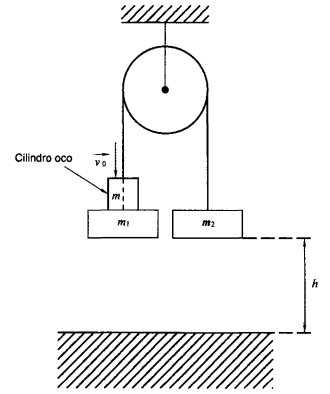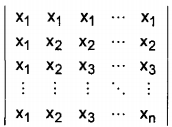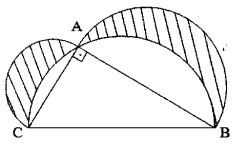Questões Militares
Para ime
Foram encontradas 888 questões
Resolva questões gratuitamente!
Junte-se a mais de 4 milhões de concurseiros!

A figura acima apresenta duas massas m1 = 5 kg e m2 = 20 kg presas por um fio que passa por uma roldana. As massas são abandonadas a partir do repouso, ambas a uma altura h do solo, no exato instante em que um cilindro oco de massa m = 5 kg atinge m1 com velocidade v = 36 m/s, ficando ambas coladas. Determine a altura h, em metros, para que m1 chegue ao solo com velocidade nula.
Dado:
• Aceleração da gravidade: g = 10 m/s2
Observação:
• A roldana e o fio são ideais.
Seja f(x) = a senx +  , onde a e b são números reais diferentes de zero. Sabendo que
f(log10(log3 10))= 5, o valor de f( log10(log10 3)) é:
, onde a e b são números reais diferentes de zero. Sabendo que
f(log10(log3 10))= 5, o valor de f( log10(log10 3)) é:
Considere o sistema de equações lineares representado abaixo:

Os valores de a e d são, respectivamente:
Seja p(x) uma função polinomial satisfazendo a relação  . Sabendo que p(3) = 28, o valor de p(4) é:
. Sabendo que p(3) = 28, o valor de p(4) é:
Em relação à teoria dos conjuntos, considere as seguintes afirmativas relacionadas aos conjuntos A, B e C:
I. Se A ∈ B e B ⊆ C então A ∈ C.
II. Se A ⊆ B e B ∈ C então A ∈ C.
III. Se A ⊆ B e B ∈ C então A ⊆ C.
Estão corretas:
O valor de y real positivo na equação  , onde x é um número real maior
do que 1 é:
, onde x é um número real maior
do que 1 é:
Uma reta, com coeficiente angular a1, passa pelo ponto (0,-1). Uma outra reta, com coeficiente
angular a2, passa pelo ponto (0,1). Sabe-se que  . O lugar geométrico percorrido
pelo ponto de interseção das duas retas é uma:
. O lugar geométrico percorrido
pelo ponto de interseção das duas retas é uma:
Sejam x1, .... xn os n primeiros termos de uma progressão aritmética, O primeiro termo e a razão desta progressão são os números reais x1 e r, respectivamente. O determinante
 é:
é:
Seja o triângulo retângulo ABC com os catetos medindo 3 cm e 4cm. Os diâmetros dos três semicírculos, traçados na figura abaixo, coincidem com os lados do triângulos ABC. A soma das áreas hachuradas, em cm2, é :

The U.S. Department of Homeland Security (DHS), which operates airport security checkpoints in the United States, is spending upward of US$ 7 million a year trying to develop technology that can detect the evil intent of the terrorists among us. Yes, you read that correctly: They plan to find the bad guys by reading their minds.
Dozens of researchers across the country are in the middle of a five year program contracted primarily to the Charles Stark Draper Laboratory, in Cambridge, Mass. They’ve developed a psycho-physiological theory of ‘malintent’ – basically, a hodgepodge of behaviorism and biometrics according to which physiological chances can give away a terrorist’s intention to do immediate harm. So far, they’ve spent US$ 20 million on biometric research, sensors, and a series of tests and demonstrations. This technology is called the Future Attribute Screening Technology (FAST).
The underlying theory is that your body reacts, in measurable and largely involuntary ways, to reveal the nature of your intentions. So as you wait in line at the airport checkpoint, thermal and other types of cameras and laser- and radar-based sensors will try to get a fix on the baseline parameters of your autonomic nervous system – your body temperature, your heart rate and respiration, your skin’s moistness, and the very look in your eyes. Then, as a security officer asks you a few questions, the sensors will remeasure those parameters so that the FAST algorithms can figure out whether you’re naughty or nice, all on the spot, without knowing anything else about you.
The U.S. Department of Homeland Security (DHS), which operates airport security checkpoints in the United States, is spending upward of US$ 7 million a year trying to develop technology that can detect the evil intent of the terrorists among us. Yes, you read that correctly: They plan to find the bad guys by reading their minds.
Dozens of researchers across the country are in the middle of a five year program contracted primarily to the Charles Stark Draper Laboratory, in Cambridge, Mass. They’ve developed a psycho-physiological theory of ‘malintent’ – basically, a hodgepodge of behaviorism and biometrics according to which physiological chances can give away a terrorist’s intention to do immediate harm. So far, they’ve spent US$ 20 million on biometric research, sensors, and a series of tests and demonstrations. This technology is called the Future Attribute Screening Technology (FAST).
The underlying theory is that your body reacts, in measurable and largely involuntary ways, to reveal the nature of your intentions. So as you wait in line at the airport checkpoint, thermal and other types of cameras and laser- and radar-based sensors will try to get a fix on the baseline parameters of your autonomic nervous system – your body temperature, your heart rate and respiration, your skin’s moistness, and the very look in your eyes. Then, as a security officer asks you a few questions, the sensors will remeasure those parameters so that the FAST algorithms can figure out whether you’re naughty or nice, all on the spot, without knowing anything else about you.
The U.S. Department of Homeland Security (DHS), which operates airport security checkpoints in the United States, is spending upward of US$ 7 million a year trying to develop technology that can detect the evil intent of the terrorists among us. Yes, you read that correctly: They plan to find the bad guys by reading their minds.
Dozens of researchers across the country are in the middle of a five year program contracted primarily to the Charles Stark Draper Laboratory, in Cambridge, Mass. They’ve developed a psycho-physiological theory of ‘malintent’ – basically, a hodgepodge of behaviorism and biometrics according to which physiological chances can give away a terrorist’s intention to do immediate harm. So far, they’ve spent US$ 20 million on biometric research, sensors, and a series of tests and demonstrations. This technology is called the Future Attribute Screening Technology (FAST).
The underlying theory is that your body reacts, in measurable and largely involuntary ways, to reveal the nature of your intentions. So as you wait in line at the airport checkpoint, thermal and other types of cameras and laser- and radar-based sensors will try to get a fix on the baseline parameters of your autonomic nervous system – your body temperature, your heart rate and respiration, your skin’s moistness, and the very look in your eyes. Then, as a security officer asks you a few questions, the sensors will remeasure those parameters so that the FAST algorithms can figure out whether you’re naughty or nice, all on the spot, without knowing anything else about you.
The U.S. Department of Homeland Security (DHS), which operates airport security checkpoints in the United States, is spending upward of US$ 7 million a year trying to develop technology that can detect the evil intent of the terrorists among us. Yes, you read that correctly: They plan to find the bad guys by reading their minds.
Dozens of researchers across the country are in the middle of a five year program contracted primarily to the Charles Stark Draper Laboratory, in Cambridge, Mass. They’ve developed a psycho-physiological theory of ‘malintent’ – basically, a hodgepodge of behaviorism and biometrics according to which physiological chances can give away a terrorist’s intention to do immediate harm. So far, they’ve spent US$ 20 million on biometric research, sensors, and a series of tests and demonstrations. This technology is called the Future Attribute Screening Technology (FAST).
The underlying theory is that your body reacts, in measurable and largely involuntary ways, to reveal the nature of your intentions. So as you wait in line at the airport checkpoint, thermal and other types of cameras and laser- and radar-based sensors will try to get a fix on the baseline parameters of your autonomic nervous system – your body temperature, your heart rate and respiration, your skin’s moistness, and the very look in your eyes. Then, as a security officer asks you a few questions, the sensors will remeasure those parameters so that the FAST algorithms can figure out whether you’re naughty or nice, all on the spot, without knowing anything else about you.